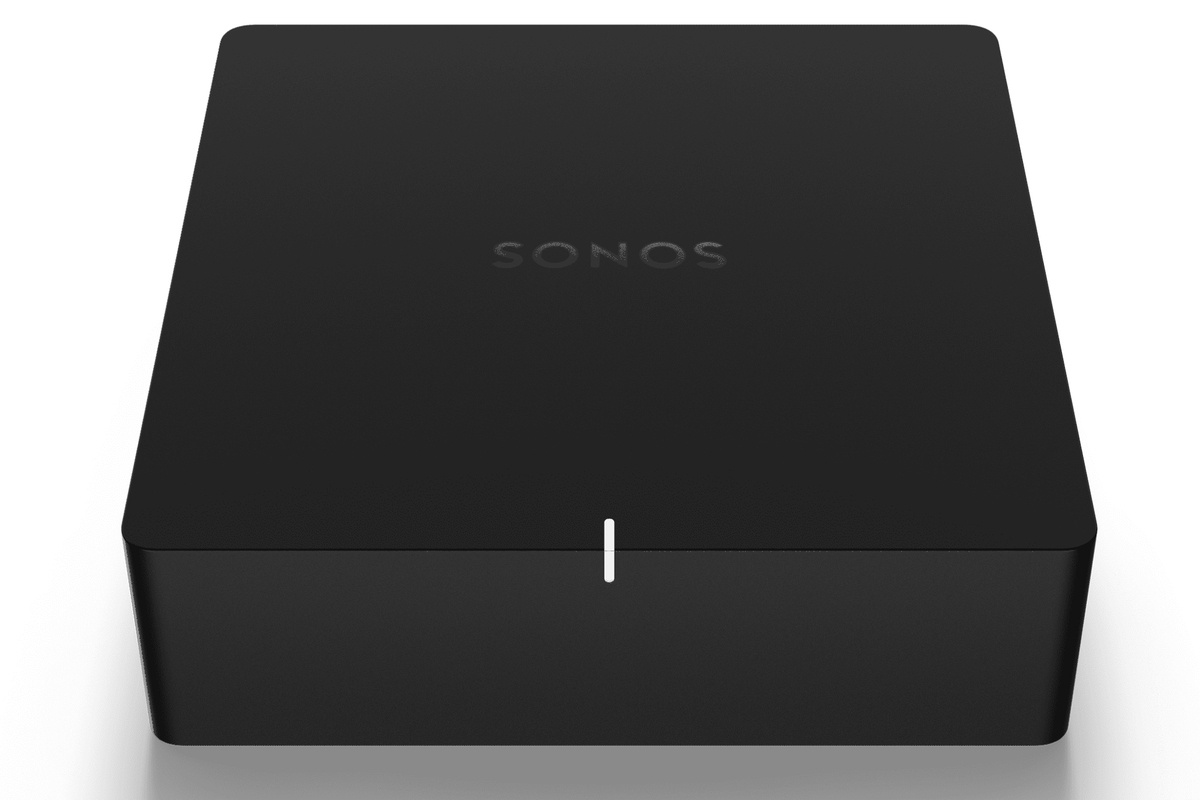[responsivevoice_button rate=”1″ pitch=”1.2″ volume=”0.8″ voice=”US English Female” buttontext=”Story in Audio”]
Sonos Port review: A mostly unworthy successor to the Sonos Connect
Sonos covers all the bases: The audio component maker builds a range of powered speakers and soundbars to stream music from every source, local or on the web, but it also offers a stand-alone tuner/amp if you want to use higher-end passive loudspeakers. And for customers who want streaming music delivered to their own favorite amp or receiver and higher-end speakers, the company launched an add-on, tuner-like component: the Sonos ZonePlayer 80 in early 2006, which was succeeded by the ZonePlayer 90 in 2008. The ZP90 was later relaunched as the Sonos Connect. That product has been succeeded by the topic of this review, the Sonos Port.
With the imminent launch of the Sonos S2 operating system, Sonos Connect owners must make a crucial decision: Replace every Connect with a Port—at $449 a pop—or forgo S2. The situation grows even more stressful if you have any combination of newer and legacy (pre-2013) Sonos hardware: The latter includes the aged Connect:Amp/ZP120 and the first-gen Play:5 speaker. Sonos says its older hardware doesn’t have enough processor power or memory to run the S2 OS, so any Sonos system that includes a mix of older and new components must be bifurcated and the two groups controlled separately (you’ll find more details in this story).
If you crave the benefits that S2 promises to deliver—including support for higher-resolution audio and Dolby Atmos (in the new Arc soundbar, for instance)—you really don’t have a choice. But if you can resist the urge to upgrade to the latest, greatest software, hang onto your legacy hardware and run it on the original platform (now called S1). That goes double for anyone who cares deeply about audio quality and has a Connect linked to high-end audio components.
After conducting a comprehensive series of A/B listening tests, I’ve concluded that the Port sounds vastly inferior to the Connect it replaces. The Port puts out decent sound, acceptable in a storm and with music you’re not intimately familiar with. But compared to the Connect, the Port’s sound field seems flattened, compressed, and so lacking in personality that you might think it was delivered by phone line.
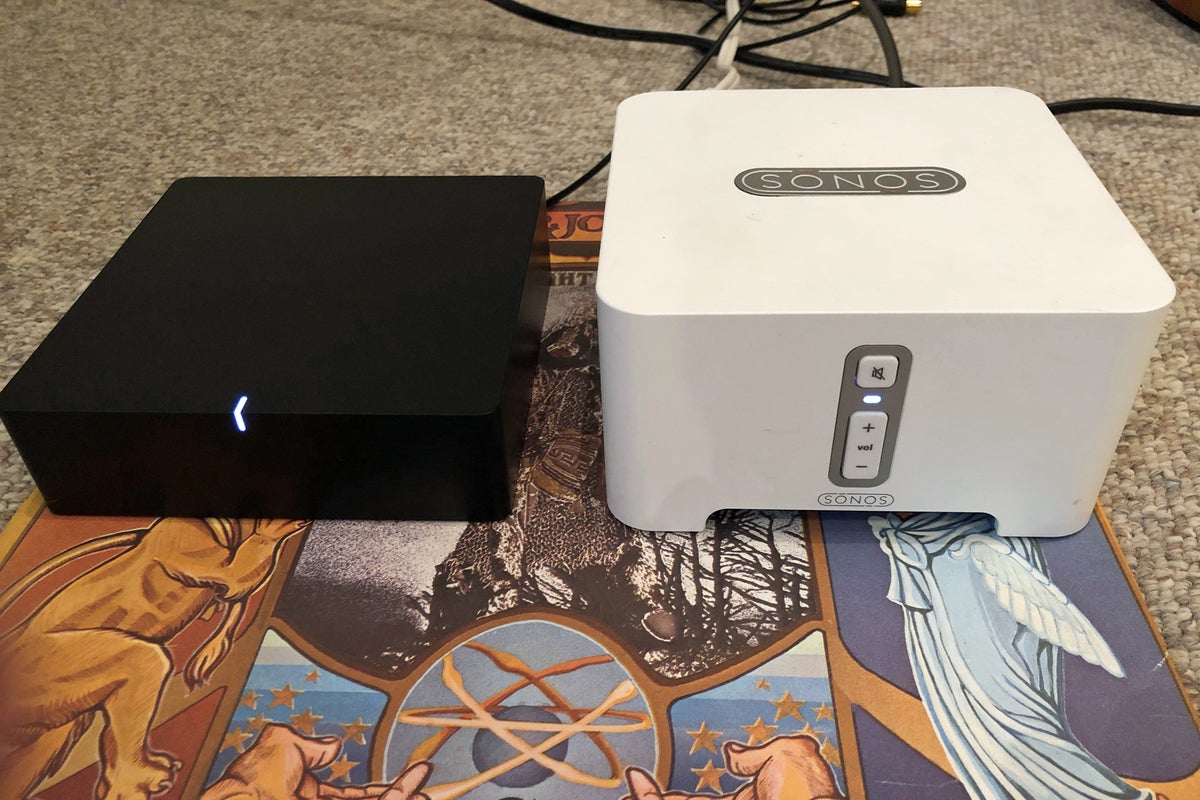 Jonathan Takiff / IDG
Jonathan Takiff / IDGOlder components like the Connect (right) aren’t compatible with the new S2 operating system and can’t be grouped with newer components that are.
Feature set
I get the impression that the Sonos product-management team started with an idealized sketch of a smaller, prettier, market-friendly successor to the clunky-looking Connect. Then the engineers went to work, squeezing in what they could to deliver a slim, trim box that looks good on a retail shelf—and that almost disappears when perched atop an A/V receiver. Most especially, something that would appeal to the custom-installer community, who will find the Port easy to use and won’t balk at its price tag (which they’ll mark way up in their quotes to their well-heeled clients).
The Port is a trim, buttonless, matte black personal-pizza box with roughly the same footprint (5.4 x 5.4 inches) of a Connect, and about half its height (1.6 inches). Three Ports will line up neatly on a standard 19-inch, 1U rack shelf. You can connect them to your home’s wireless network (the minimum requirements are very low: 802.11b/g, 2.4GHz); or for the most reliable performance, you can hardwire it to your home’s router using the 10/100Mbps ethernet ports in back. There are two of those, so you can gang a bunch of Ports together and consume just one port on your router or switch.
The Port runs cooler than the Connect and in a wider range of environments—from 32 degrees Farhrenheit to 104 degrees F. The manufacturer mildly discourages users from stacking Ports, however; mostly because it can lead to Wi-Fi interference. The Connect’s volume up/down and mute buttons have been excised, but the Port’s LED on-and-connected indicator looks snazzier than that of its predecessor.
The ethernet ports on the backside of the Port are joined by one set of analog stereo inputs for a CD player or turntable preamp (or a turntable itself, if it has a preamp built in), and one set of analog stereo outputs for connecting an amplifier or self-powered speakers. There’s a coaxial S/PDIF connector should you own a cherished outboard DAC—or simply want to keep the signal in the digital domain until it reaches your DAC-equipped receiver or pre-amp. But I’m disappointed that Sonos decided not to also carry over the Toslink digital audio output from the Connect. I know custom installers prefer to use coaxial cables, because their connectors are much less fragile than the ones on Toslink cables and coax cables perform better over long runs, but Toslink is far more common on less-expensive audio components.
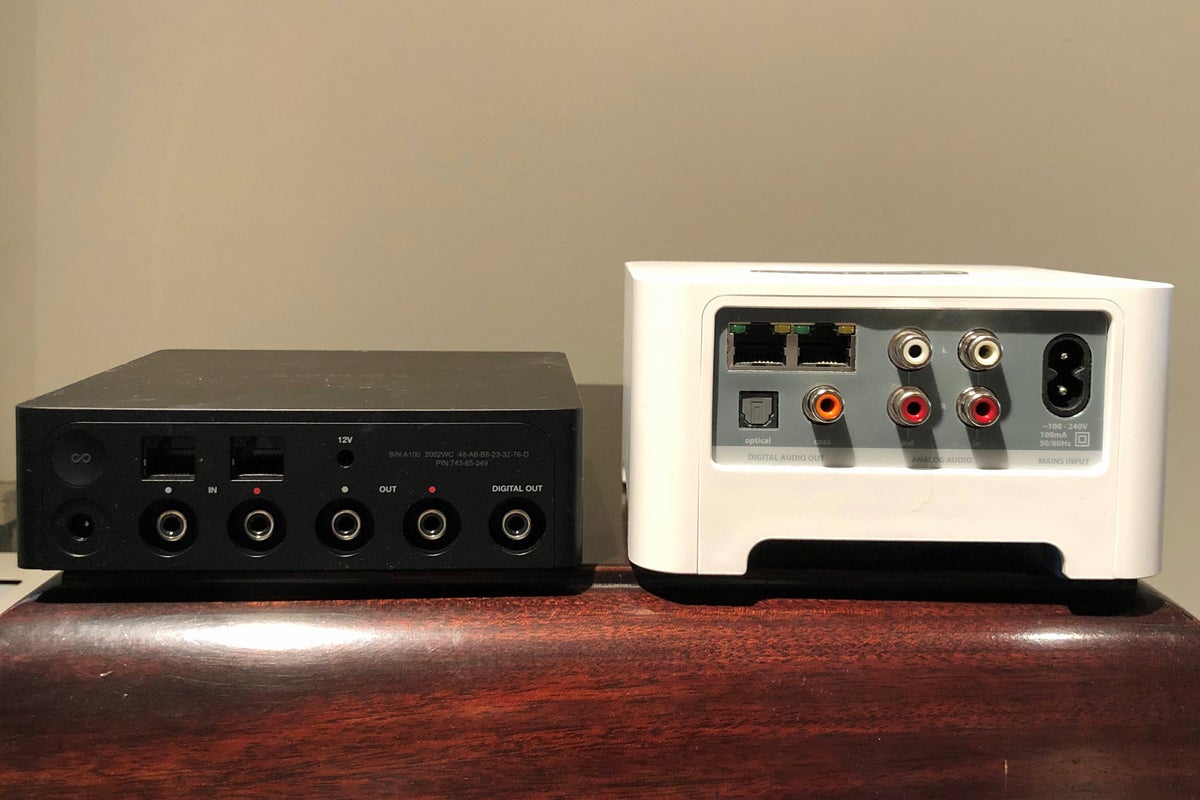 Jonathan Takiff / IDG
Jonathan Takiff / IDGThis I/O port comparison shows the similarities between the new Port and the old Connect. Many will mourn Toslink’s absence on the Port. Could it have added that much expense to the bill of materials?
On the upside, Sonos added a 12V trigger that you can use to automatically fire up a connected amplifier or A/V receiver when the Port starts playing music, eliminating the steps—and footsteps—needed to get your next listening session started. Lastly, there’s a “Join” button for adding a Port to your Sonos system, which you’ll use in conjunction with the company’s exceptionally polished, full-service app.
More horsepower
The Port is outfitted with a beefier microprocessor and more memory than what comes in the Connect, and that additional muscle is required to run the new Sonos S2 operating system. And unlike the Connect, the Port is compatible with Apple’s Airplay 2 multi-room audio technology, enabling you to mix Sonos components with other AirPlay 2 compatible devices—including Apple’s HomePod smart speaker—on the same network. Airplay 2 worked quite well for me: Flawlessly with content from the Amazon Music app beamed from an iPhone X, and pretty well—hardware recognition/connectivity quirks aside—with other music apps. The Port forwarded a consistent and bright sounding stream of music to as many as six other Sonos speaker locations sprinkled around my house. Kudos for that.
The Port doesn’t have a microphone, but it can be controlled with voice commands spoken to any smart speaker powered by Amazon Alexa or Google Assistant. Apple’s Siri is also supported, but much less robustly.
The re-transmission of line-in signals fed into a Port can get a little iffy. At first, a plugged-in Audio Technica AT-LP60X turntable (which has an onboard phono preamp) played fine through the Port and on to my connected A/V receiver (a Yamaha Aventage RX-A3060) and speakers (a much-loved pair of floor-standing B&W Nautilus 803s). I noticed just a tad of lag on a grouped Sonos Play:3 speaker located in the next room (the first-gen Sonos Play:5 is the only speaker that isn’t S2 compatible).
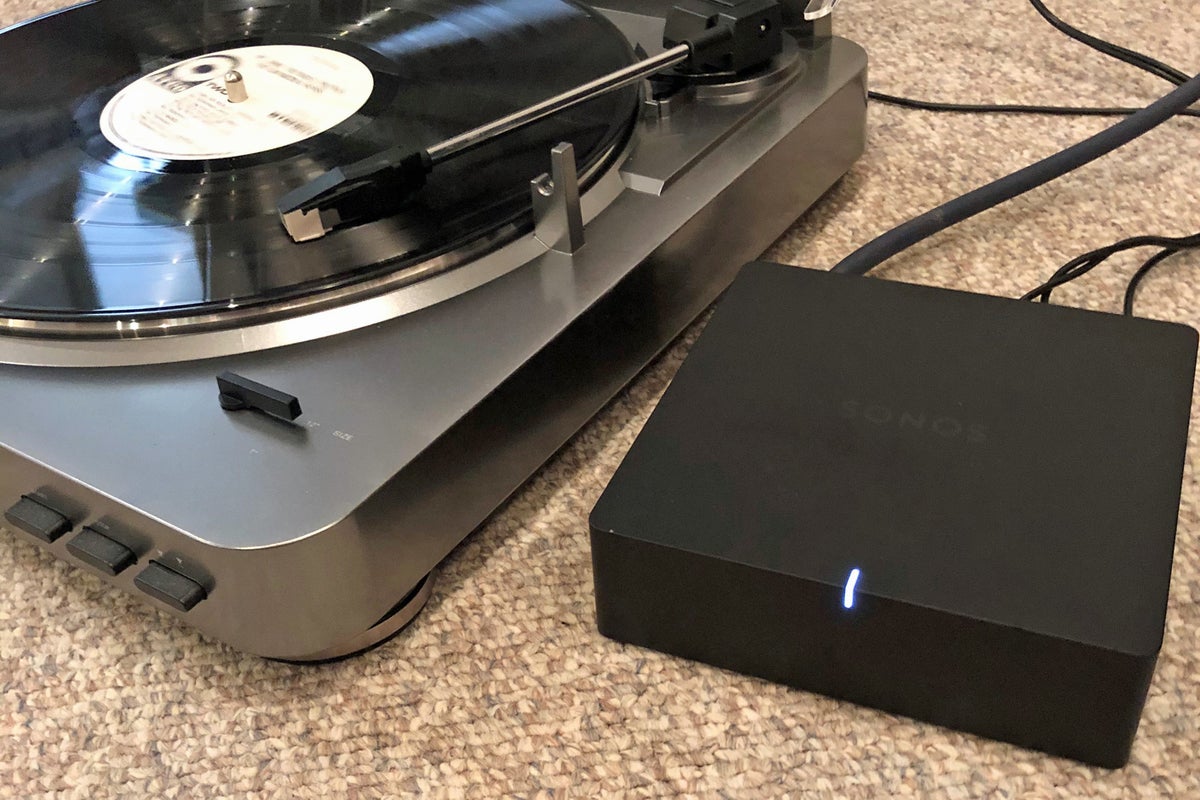 Jonathan Takiff / IDG
Jonathan Takiff / IDGA Sonos Port can add whole-home music streaming to a turntable that has an integrated pre-amp, like this Audio-Technica AT-LP60X (you’ll need an outboard pre-amp if your turntable doesn’t have one).
But when I added multiple other Sonos speakers to the group, I encountered annoying signal dropouts—audio blips happening on the average of one every 30 seconds. Venturing into the Sonos app settings and stepping up the Port’s audio delay from the default “Low” setting of 75ms to the “Max” setting of 2,000ms (two seconds) finally resolved that issue. But that change simultaneously cued the Port’s auto-compression circuitry to shift from sending audio in the uncompressed WAV format to sending compressed audio (using the SBC codec), which is much less taxing on a home network. The latter thinned the sound some, although the stability trade-off was worth it.
What initially excited me about Sonos’ new S2 platform was Sonos’ promise to support higher-resolution audio technologies, compared to the CD-quality (16-bit/48kHz) audio supported by the current OS. Some of the newer Sonos speakers—including the Arc soundbar—will deliver Dolby Atmos, too. Presumably, that means the Arc will support Tidal streams encoded with Dolby Atmos Music, although that is yet to be confirmed.
Also unknown: If Sonos S2 will support MQA encoding or the Sony 360 Reality Audio format, both of which are available to Tidal HiFi subscribers (the latter is also available via Amazon Music HD). Qobuz, meanwhile, offers the highest-resolution tracks of them all—up to 24-bit/192kHz—while Spotify doesn’t even try to compete on that score, offering streams at a maximum bit rate of 320Kbps.
 Jonathan Takiff / IDG
Jonathan Takiff / IDGThe footprints are just about the same, but Port has half the height and none of the volume-control buttons found on the Connect.
Nose to nose: How the Port blows
Unable to score a review unit from Sonos, and suffering from an acute case of FOMO, I broke down a couple of months ago and bought two Sonos Ports to replace my Sonos Connects. After performing my head-to-head comparison, I’m getting ready to send one back.
My lifelong faves, the Rolling Stones, gave me ample test material with the 2019 deluxe edition of their career-spanning, 46-track compilation album Honk. It’s heavy on remastered studio hits that I know and love, whilst also made special and “new” with a third CD’s worth of recent, very well-recorded concert performances.
I piped this in from Qobuz running at its “CD-quality” service level, delivered to my gear in parallel through a fiber optic cable-connected Connect and a coax cable-connected Port “grouped” in the Sonos app in perfect synch. Levels were balanced, loudness was “off,” and EQ settings were flat. I later tried tweaking the bass and treble settings on the Port to see if that could improve its performance, but ultimately decided the changes didn’t do it any favors.
Time and again, I heard the same disparity. When playing through the Port, it seemed as if the musicians were squeezed together, the singers massed as a choir, the plugged-in guitar and bass players all broadcasting through a single amp. Listening on the older Connect, by contrast, I could peel apart the layers of the onion; say, with Mick carving out his own territory and playing more dynamically off backing singers and special concert guest vocalists (Brad Paisley in Philly on “Dead Flowers,” or Ed Sheeran on “Beast of Burden” in Kansas City).
The comparisons just went from bad to worse. On the Port, I heard less personality and grit in Keith’s and Ronnie’s guitars. Solos sounded flat as pancakes. On the Connect I could practically “see” the strings wobbling and (on acoustic cuts like “Wild Horses”), I could hear the rich hollow-body resonance of Keith’s slide guitar.
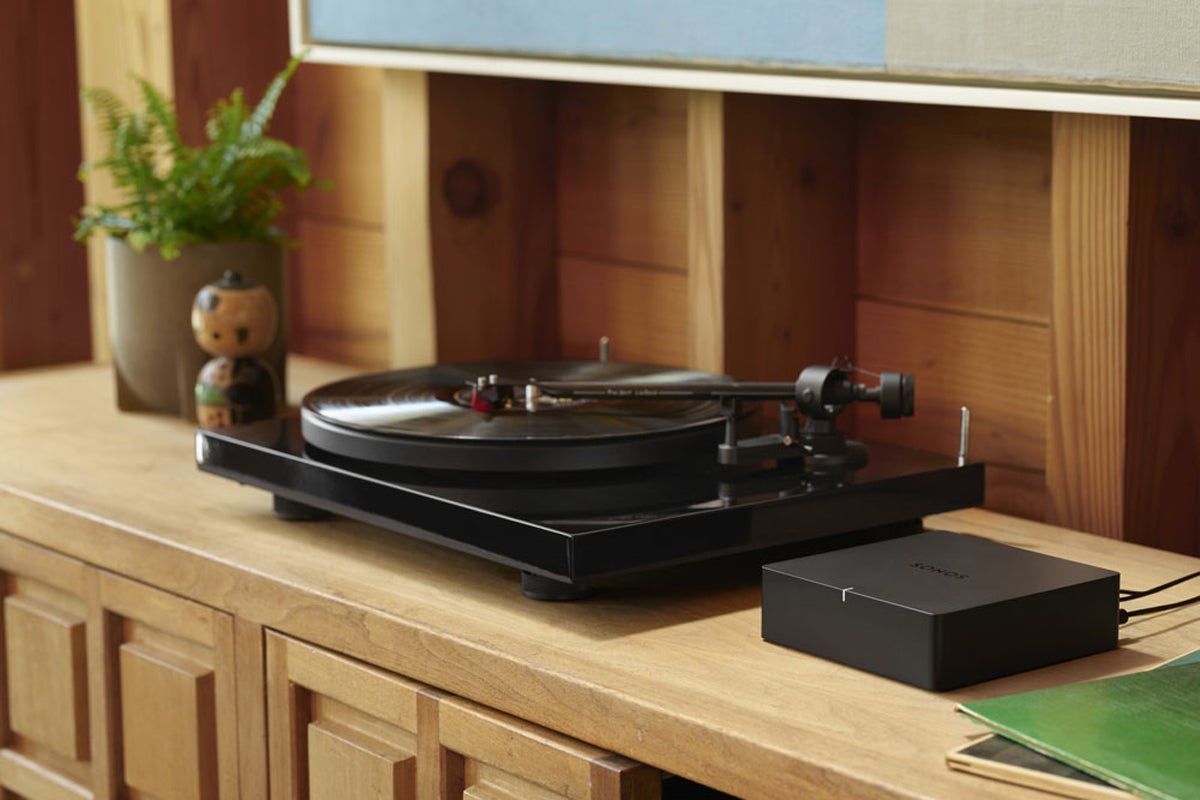 Sonos
SonosThe Sonos Port will at least look pretty next to your home audio components.
Most telling, and comparatively painful, was the discernable difference in Charlie Watts’ percussion work, especially on that live concert material. Played through the Port, it often sounded like Watts was just dutifully marking time, with the rest of the band sitting in his lap, muffling his efforts. On the Connect, I could visualize, sense that the drummer was upstage of the rest of the group, living large and having fun—his splashy sound emboldened with slap-back echoing off the back wall. This was the deep, wide “live on a big stage” aural sensation I first heard and learned to love on classic concert recordings of the 1970s–including the Woodstock festival sessions and the Allman Bros.’ At Fillmore East.
Back on the Stones’ “Honk” concert tour, the worst comparisons were noted on the set closing “Under My Thumb” (captured at London Stadium) and “Bitch” (with Dave Grohl at Honda Center, in Anaheim, CA). When the Port was playing, I felt like I was sonically repressed, too, stuck in the back of the joint under a sound-muffling upper deck. Lots to bitch about.
On the Connect I was out on the field, stage lights shining in my eyes, spitting distance from the stage, feeling the urgent give-and-take of the players.
These stunning differences held up with other content, too, including an especially artful episode of the Sunday show Guy Garvey’s Finest Hour, on BBC Radio 6 (via TuneIn). The focus was on female singer/songwriters (Cat Power, Jesca Hoop, k.d.lang, and Kate Bush) backed by pianos and acoustic guitars, woodwinds, and lots of unamplified strings (violins and cellos). This is one of the most challenging types of music for home audio gear to reproduce in a way that sounds natural, and the Port failed the test.
 Michael Brown / IDG
Michael Brown / IDGIt’s a shame Sonos didn’t build touch-sensitive volume controls into the Sono Port they way it did with the Sonos Amp, which also has play/pause button.
Pretty vacant
I was struck again and again by the Port’s relative absence of personality. It reminded me of the highly compressed sound that rival FM rock radio stations in the Philadelphia market took on in the progressive music era, when I myself was on the air. The broadcast engineers installed Optimod dynamic range compressors to keep the meters peaking, the sound louder than the competition, and to hell with dynamics and finesse.
Can Sonos fix what ails the Port, reshape its sound profile with just a software tweak, as it managed to do with the Playbar six to eight months after it came out? The company’s sound experience leader—famed producer Giles Martin— nudged the company to pull that mission off because “there was just something in the sound in the Playbar that just wasn’t quite right to him.”
Sonos CEO Patrick Spence discussed this in a September, 2019 interview with Nilay Patel on The Verge. You can listen to the relevant snippet of the podcast about 39 minutes in, at this link (the playback tool provides an easy way to jump right to that part of the interview). Can a lowly audio critic or two motivate Sonos in the same fashion? I’ve recently become aware of a review at Britain’s What Hi-Fi! that contains similar observations about the Port, but most of the other critiques I’ve read seem to assume that newer=better.
As for me, I’ve given up on the notion of switching my house full of Sonos gear so that everything will be compatible with Sonos S2. I’ll keep one of the Sonos Ports I’ve purchased so I can see what S2 is all about, but I’ll live in a mostly S1 Sonos environment until a demonstrably higher-resolution streaming-audio service is on offer, or until some other compelling innovation—wireless Sonos headphones, perhaps—comes to market.
The irony of my Port/Connect comparison is that it underscores just how good CD-quality music can sound—with the right gear. So, why ask—or pay—for anything more?















